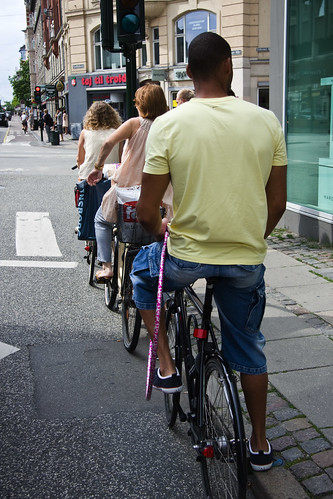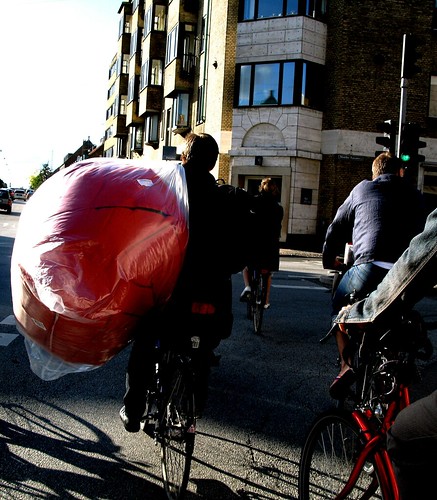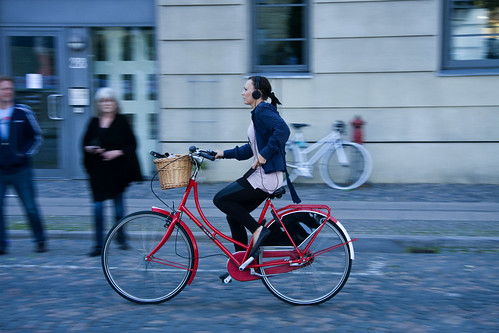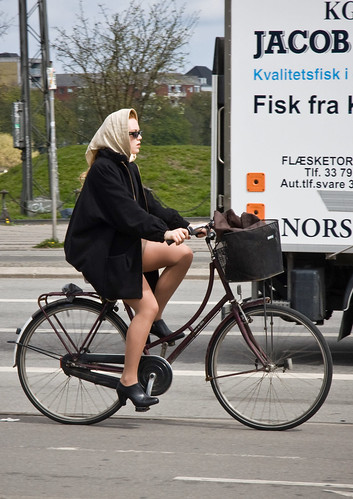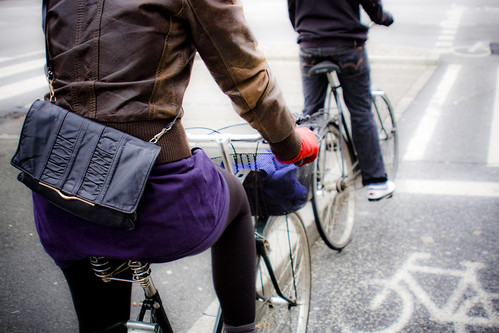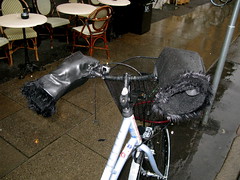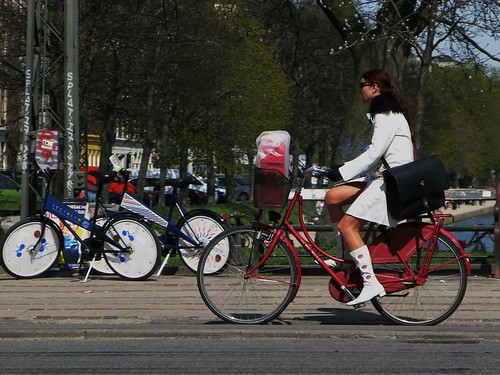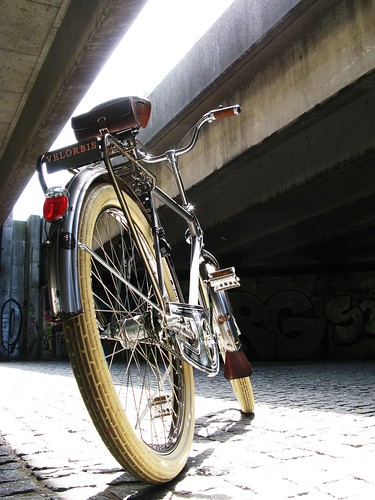
After seeing an article about bicycles in a Danish fashion magazine for men called
Euroman, I thought it necessary to pen this post. The Euroman article was about 'cool' bikes and the bikes were, by and large, frightfully expensive racers. Considering the fact that this magazine attempts to represent 'cool' Danish men, it was odd that their article reeked a bit too much of 'toys' and 'gear'. The bikes, with the exception of the
Bullitt by Larry vs. Harry, were not bicycles ridden around Copenhagen by bespoke sartorial-minded gentlemen.
This dismal cyclo faux pas by
Euroman begged the question: what bicycles should discerning, elegant and modern gentlemen prefer to ride in buzzing urban centres on their way to a café for an afternoon beer after a demanding meeting at the ad agency/law firm/photo studio/et al? Here's Copenhagen Cycle Chic's opinionated view.
THE SCRAP DELUXE BY VELORBIS [DENMARK]As any dedicated reader to this website knows, I prefer my
Scrap Deluxe from Velorbis, as pictured above. It's cheeky, flirtacious and yet urban to a tee. The sophisticated form and the balloon tyres beg for style over speed and I rarely let it down. Although the
Churchill from Velorbis is a fantastic option as well.
They say it best themselves:
"We put our heart and soul into all of our bicycles - every component or design feature has been well considered for its functionality, compatibility and overall aesthetic."VELORBIS was born from the hunt for a desirable bicycle on which to cycle around London as an alternative to public transport after the London bombings in 2005. The bicycles are made in Northern Germany, shunning the exodus to China and Taiwan that many bike brands have made.
Danish design and Copenhagen style. Period.
THE CLASSIC BY ARROW [JAPAN] Arrow bicycles
Arrow bicycles are exquisite machines. Stylish, functional and simple, like much Danish and Japanese design.
Jimbei Yamada started selling his cult bikes in Tokyo back in 1972. His slogan, visible above the door to his shop, says it all: "Simple is Best".
He sells basic designs available in 18 colours. Customers can buy them assembled or they can buy them as kits. Many customers chooose to assemble them themselves in the shop, under Yamada's supervision and under another sign that reads: "Your bike made by yourself".
As Yamada says, "I realised that if I could do it, anyone could."
In Yamada's eyes a city bike should be strong, narrow and light. Two of his most popular makes are the Yamajin and the Classic [pictured above].
Arrow only produces about 1000 bikes a year. Yamada doesn't fancy the idea of expanding. Too much stress. He currently has his main shop and four franchises around Japan. He purchases the best parts and that is what makes his bikes so good in a world of cheap bikes.
What endears us most to Yamada and Arrow is his disdain for branding. There is no Arrow logo on any of his bikes.
"You've already paid for the product; I don't see why you should advertise it too", he says.
THE CITY CLASSIC MAN BY CICLO ADRIATICA [ITALY]
The
Cicli Adriatica bicycles, above, were recently discovered in a foreign fashion magazine by
Wifealiciousness, so I dutifully sought them out on the internet. Merely because they're beautiful, normal bikes for everyday use in all urban landscapes. Mostly because they're beautiful.
How I yearn to ride one through the winding streets of some Italian city, nodding knowingly at other well-dressed cyclists who pass by.
THE IMPERIALE UOMO BY UMBERTO DEI [ITALY]
The name of this bicycle alone makes us sigh. The Imperiale Uomo by
Umberto Dei. This bicycle evaded our bespoke bike radar for a long while until an Italian friend put us onto it. We're glad he did.
The brand has a history it seems, which adds to the allure:
"
It happened in the year 1896. The Lumiere brothers had just invented cinematography and Guglielmo Marconi had created the wireless telephone when a little artisan, fond of cycling and extremely meticulous, made his first series of bicycles. His name was Umberto Dei.
"That was the beginning of a marvellous adventure that led him to create a collection of bicycles which were considered among the best in the world. Their level of quality and perfection was so high that the brand Dei became world-known: everybody longed to have a Dei bycicle and win by riding it."
All fine and dandy with a bit of history from the glory days of racing. But we're well pleased that the company produces bicycles for gentlemen like the Imperiale Uomo. I want one, desperately. At €1300, I'll have to wait six months or so. Global financial crisis and all that.
THE LIGHT ROADSTER BY A.N.T. BIKE [USA] The A.N.T. Bike
The A.N.T. Bike [ANT meaning 'Alternative Needs Transportation'] is a labour of love produced in a town called Holliston, Massachusetts, USA.
Hand crafted bikes with each their own personality. Organic metallic wonders that are designed for style and function. As Danes, with a long history of design, those two words are music to our ears and the bikes we've seen on the website are operas for our eyes.
They target the needs of the city cyclist and create bikes that suit the individual.
"
We not only hope to meet the needs of people's commuter bikes, but to influence the consumers to think about bicycle commuting in a more positive way. We love all types of cycling but feel that there is a real need to bring to the table bikes that have the right combination of style and function that is so lacking in the market."
While we lament the fact that we have never ridden an ANTBIKE let alone stroked our fingers over the cool, smooth frame of one, we are quite convinced that they exude bespoke coolness. From what we gather there is quite a waiting list for one of these beauties, so get your deposit paid and settle back to enjoy the anticipation.

One little detail that tickles us pink is the hand-crafted logo. It's just leapt to the top of our unofficial list of coolest bike logos. Ever ever ever. It's an ant. It's an A and a N and a T. And it is just as rusty as most bikes in Copenhagen. We want a large one for our wall.
THE PEDERSEN [DENMARK]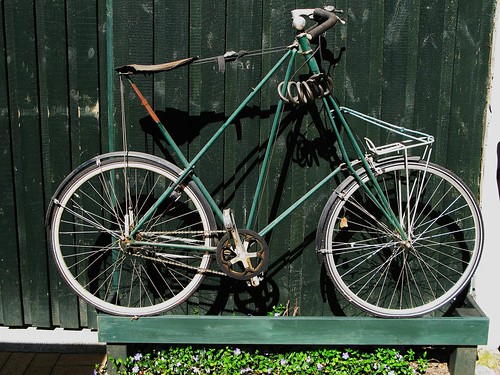
As far as sitting up straight in style, as your mother taught you, the Pedersen is hard to compete with. As far as stories go, the Pedersen bicycle story beats them all.
Mikael Pedersen, a Dane, moved to England and with the help of a financier started a bike company featuring his unique frame. It was called the Dursely Pedersen back then, after the town of Dursley where he settled. All went well for a while but he ended up losing control of his patents and designs and ended up dying a pauper in Denmark.
The designs were found and revived by Jesper Sølling in 1978 and the bicycles are now much sought after. The town of Dursley had his remains sent over in 1995 and erected a memorial in his honour.
The story in full is here.
The bike is a timeless classic and definately looks best when ridden in an expensive suit.
Do let us know if you know any other bicycles that may apply to this bespoke category.

